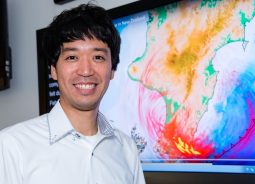Yoshihiro Kaneko

2016: Dr Yoshihiro Kaneko, GNS Science, Tectonophysics, has been awarded a Rutherford Discovery Fellowship for research entitled: 'Structural controls on earthquake behaviour in the Hikurangi subduction mega-thrust'.
Biography
Dr Yoshihiro Kaneko is a seismologist at GNS Science. His research focuses on understanding and quantifying earthquake source processes and their relation to crustal deformation and seismic hazard. He completed his PhD in geophysics from the California Institute of Technology in 2009 and was a Scripps postdoctoral fellow at the University of California – San Diego before moving to New Zealand in 2013. Since then, he has established the use of high performance computing capability for earthquake research at GNS Science and has been conducting numerical simulations of seismic wave propagation and earthquake rupture. This has opened up new research directions in New Zealand, as reflected by both the 2015 Marsden Fast-Start and 2015 Natural Hazards Research Platform projects for which he is Principal Investigator. He is also an Associate Editor for the Journal of Geophysical Research – Solid Earth.
Research summary
The Hikurangi subduction zone beneath the North Island of New Zealand, where the oceanic Hikurangi Plateau is subducting beneath the continental crust of the Australian Plate, is capable of producing destructive mega-thrust earthquakes like the 2011 Tohoku-oki earthquake in Japan. Two decades of geodetic monitoring has revealed that the large portion of the Hikurangi plate interface (i.e., the fault between the two tectonic plates) is currently locked, implying that stress is building up for the next large mega-thrust earthquake. However, there is a dramatic variation in the degree of locking over the length of the fault, with complex patterns of seismic and aseismic (earthquake-free) fault slip. Scientists have observed similar patterns of mega-thrust slip behaviour at many other Pacific-Rim subduction zones. However, the underlying mechanisms controlling the variability in fault slip behaviour at Hikurangi, as well as at other subduction zones, are not well understood.
With this project, Dr Kaneko will use state-of-the-art seismological techniques and numerical modeling, combined with existing and new seismic datasets, to shed light on the underlying mechanism of complex mega-thrust slip behaviour at subduction plate boundaries. In particular, he will image details of the 3D structure and geometry of the Hikurangi mega-thrust region using a technique called seismic tomography. Using the gained knowledge, he will then develop a dynamic model of crustal deformation that can reproduce a range of fault slip behavior at the Hikurangi subduction zone. This work will lead to a much improved understanding of earthquake behavior in the Hikurangi subduction zone, which will result in New Zealand being better prepared for the next megathrust earthquake.
Given the coverage of existing and proposed seismometer networks, well-recorded earthquakes, and the shallowness (12-25 km depth) of the subduction interface beneath the network, the Hikurangi region offers a unique opportunity for seismological investigation of the detailed material properties in the plate-locking ‘transition zone’. Well-resolved structural and material properties combined with advanced physics-based models of seismic and aseismic fault slip will provide critical insights needed to answer the globally significant question: what controls the spatial variation of mega-thrust slip behaviour and the spatial extent of large subduction earthquakes.
